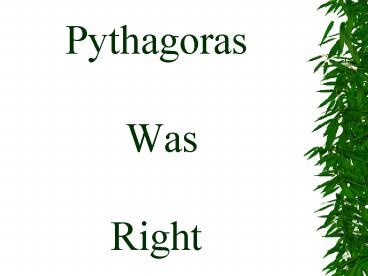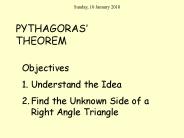Pythagoras Was Right - PowerPoint PPT Presentation
1 / 25
Title:
Pythagoras Was Right
Description:
What does this mean in plain English? Find the length of the shortest side. ... to measure the approximate height of the flagpole in front of the school or the ... – PowerPoint PPT presentation
Number of Views:90
Avg rating:3.0/5.0
Title: Pythagoras Was Right
1
Pythagoras Was Right
2
The Pythagorean Theorem
- This theorem states that in any right triangle,
the square of the length of the hypotenuse equals
the sum of the squares of the lengths of the legs.
3
What does this mean in plain English?
- Find the length of the shortest side.
- Square that number (multiply it by itself).
- Find the length of the next longest side.
- Square that number.
- Add those two numbers together.
- Find the length of the longest side.
- Square that number.
- Your answers in numbers 5 and 7 should be the
same.
4
Show me an example
3
- One leg is 3 units long
- The second leg is 4 units long
4
5
- The hypotenuse is 5 units long, because
5
- 32 9
- 42 16
- 9 16 25
- 25 5
(something is wrong, so click once more)
6
A brief review can youdefine these words?
- Theorem
- Hypotenuse
- Legs
7
A theorem is a statement that is shown to be true
by use of a logically developed argument.
8
The hypotenuse of a right triangle is the longest
side of the triangle and is opposite the right
triangle.
9
The legs of a right triangle are the two short
sides that form the right angle.
10
If you know all of the lengths, this is just
ducky. What do you do if you do not know all of
the lengths? Can you solve for the the
hypotenuse if you know the two legs? Can you
find the length of one leg if you know the
hypotenuse and the other leg?
11
If you know how to use this equation, you can
solve these problems.a2 b2 c2 Where a
and brepresent the length of the legs, and c is
the length of the hypotenuse.
12
Show me two examples
- Suppose the two legs (a and b) are 5 and 12 units
long.
c
5
12
- What is the length of the hypotenuse c?
13
Write the equation a2 b2 c2 Substitute the
values that you know a5 and b12(or
vice-versa). The value of c is unknown, so the
equation now becomes 52 122 c2. Show your
steps and solve for c2. The next slide shows a
nice set-up.
14
2
2
2
a
b
c
2
2
2
12
c
5
2
25
144
c
2
c
169
169
2
c
c
13
15
So, if you dont know the hypotenuse, square the
legs and add them. The hypotenuse is the square
root of that sum.
16
On the other hand, if you know the length of the
hypotenuse and one of the legs, square those two
values and subtract them. The square root of
that answer is the length of the unknown leg.
17
Show me an example
Suppose the hypotenuse has a length of 20, and
one of the legs is 12. What is the length of the
other leg? We rearrange the equation by
subtracting b from both sides of the equation
2
2
2
2
2
a
-
2
b
b
c
-
b
2
2
c
-
b
2
a
2
2
2
a
20
-
12
2
400
-
144
a
2
256
a
2
a
256
a
16
18
Here is another variation you may want to use.
c
2
1)
2
a
b
And also
-
2)
2
a
c
2
b
19
Use the first equation if you do not know the
length of the hypotenuse, while you use the
second one if you do not know the length of one
of the legs
20
Lets see how this works if the legs are 6 and 8
units.We know the length of the legs, so we use
equation 1.
c
a
b
2
2
c
2
2
6
8
36 64
c
21
36 64 equals 100
And what is the square root of 100?
Right, it is 10.
Can you use equation 2 if the hypotenuse is 15
units and one leg is 12?
22
2
2
c
a
-
b
2
2
c
15
-
12
c
225
-
144
c
81
c
9
23
Therefore, the lengths of the legs are 9 and 12
units, while the hypotenuse is 15 units. Do you
see a relationship between some of the triangles
you have studied? What pattern do you see in 3,
4, 5 6, 8, 10 and 9, 12, 15?
24
ChallengeHow could use a meter stick and a tape
to measure the approximate height of the flagpole
in front of the school or the campanile on the
SDSU campus?
25
Additional Resources
- http//www.pbs.org/wgbh/nova/proof
- http//www.cut-the-knot.com/pythagoras
- http//www.frontiernet.net/imaging/pythagorean.ht
ml - http//www.nadn.navy.mil/MathDept/mdm/pyth.html
- http//www.geom.umn.edu/demo5337/Group3/bball.htm
l - To return to home page, click here































